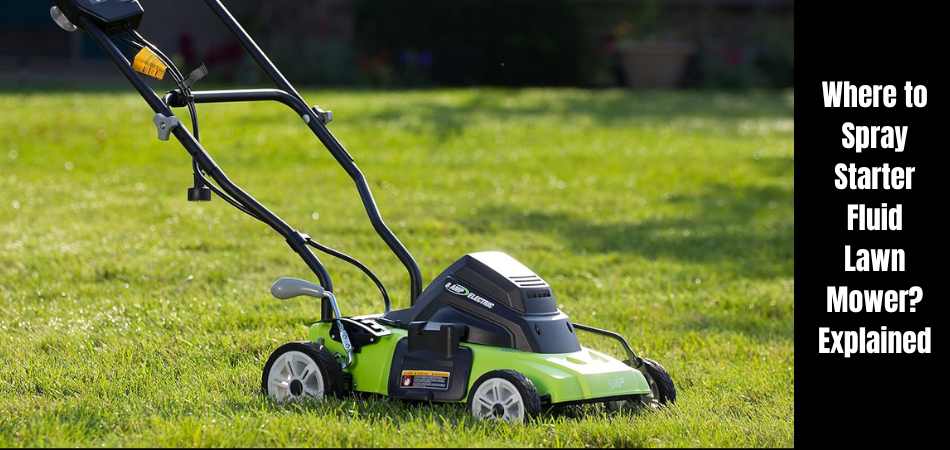
Starting your lawnmower after it has been unused for a while can be difficult. You neglected some maintenance, did not properly winterize it, or there are other reasons. When a lawnmower doesn’t start, you must diagnose the problem and use starter fluid. But, Where to Spray Starter Fluid Lawn Mower?
Most of the time, the problem is caused by a blockage in an engine component. It could also be a sparkplug problem. Such an engine can be started with starter fluid, and the underlying problem can be diagnosed quickly.
This article will briefly discuss Where to Spray Starter Fluid Lawn Mower and how to use it. So let’s get started.
What is starter fluid?
An ignition starter fluid consists primarily of hydrocarbon (fuel), diethyl ether, and carbon dioxide, which are highly flammable and volatile. In most cases, starter fluid is enclosed in a pressurized spray can.
As soon as the trigger is pressed, the starter fluid atomizes in the direction of the spray. As a result, it is more likely to react with air and mix properly.
It can be harder to diagnose lawnmower engines than car engines because lawnmowers are smaller than cars. Push mowers, and most other mower types are usually powered by two-stroke or four-stroke engines with one or two cylinders.
There can be various reasons why a mower will not start, from a bad spark plug to a lack of fuel.
When to Use Starter Fluid?
As its name suggests, starter fluid starts a difficult-to-start engine. It is beneficial for cold starts in the fall and early spring when the engine is not used often.
It is possible to improve the starting of an engine in cold weather if starter fluid is used. Getting your lawnmower started can be challenging when the temperature is low.
Starter fluid can help diagnose problems with starting your lawnmower if there is an underlying cause.
You can save time by learning how to use starter fluid properly. After reading this blog, you can ask a professional for help if you still have problems.
What are the Required Tools to Spray Starter Fluid?
It is not challenging to spray starter fluid. To do it, you’ll only need a few basic tools:
- Wrench set
- Screwdriver
- Grip Pliers
- Collector Pan
- Cleaning cloth
- Starter fluid
Where to Spray Starter Fluid Lawn Mower?
A step-by-step guide Where to Spray Starter Fluid Lawn Mower:
- Step 1: Locate the air filter housing
- Step 2: Remove the air filter and clean
- Step 3: Find the carburetor chamber underneath
- Step 4: Spray the starter fluid
- Step 5: Start the engine and diagnose
- Step 6: Check, clean, and fix the part that causes the problem
Let’s get started.
Step 1: Locate the housing for the air filter
When working on a riding mower, lift the hood or remove the engine cover. If you have a push lawnmower, you will need to locate the cover’s latches, clips, and bolts. Once you have located the bolts and clasps, remove them. You will need to lift the cover.
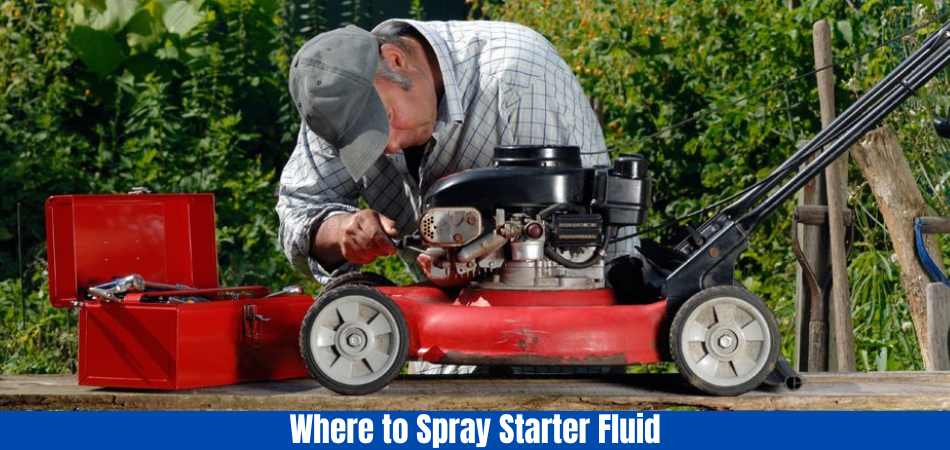
The air filter housing can be found on the front of your lawnmower engine. It has an opening shaped like a fin. There is an air intake box and an air filter in this box. The air will then be mixed with the fuel and presented to the carburetor for mixing with the fuel.
Step 2: Take off the air filter and clean it
In most cases, the black cover of the air filter housing is fixed with latches and easily removed. Keep the plastic intact by not breaking it. The cover of some mowers is fastened in place with fasteners. Using a socket wrench, you can loosen them.
You will find a mesh filter underneath the cover. Paper or foamy soft filters are used.
Normally, the filter is easy to remove. Some filters use bolts. Then, remove the air filter by unscrewing the bolt with a torque wrench. The filter is quite delicate, so be careful not to damage it.
You should clean your foam air filter if you have one. The first step is to remove any apparent debris and mud by carefully tapping it. Dry or wet cleaning is both possible for the air filter.
Using a vacuum will allow you to dry clean it quickly. Ensure that the air filter is not damaged. You can also use dishwashing soap or detergent if you have more time. Before using it, let it completely dry.
Pressurized air can also be used to clean it. Air compressors can be dangerous, so use them carefully. The air filter can be damaged quickly if exposed to vital air. You should replace your paper air filter if you have one.
The foam air filter must be replaced if it is damaged or has a paper air filter. Make sure you purchase the right type of replacement filter for your lawnmower.
Step 3: Find the carburetor
The carburetor is often located behind the backplate of the air filter housing. You can easily locate it by following the fuel line from the gas tank. The carburetor mixes the air from the air filter with the gas and sends it to the engine.
Make sure the external parts are clean: Clean the visible ports and grooves of the carburetor with some cleaning cloth if you have the time. You can start your lawnmower more easily if your carburetor is clean.
Step 4: Apply starter fluid
Having cleaned the air filter and carburetor, it is time to use the starter fluid:
Using a clean cloth and some all-purpose cleaner, clean and dry the backplate of the housing.
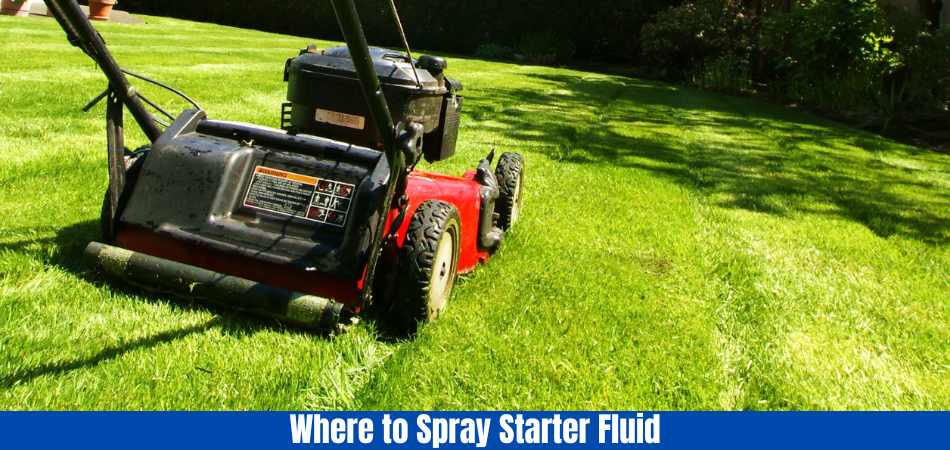
Identify the intake duct: The carburetor’s backplate has a cutout through which air enters. There will be a breather tube at the end of this intake duct.
The starter fluid should be sprayed into the found opening. As a result, the starter fluid is entering the carburetor chamber.
Step 5: Turn on the engine and observe
You can adjust the idle and choke by adjusting the throttle halfway if it is adjustable. The choke should be lifted to the full position. As a result, fuel intake will be significantly increased.
Turn the ignition switch or pull the starting cord to start the engine. If you add starter fluid to the engine, it should start. Pay close attention to what is happening.
It is a good sign if the mower continues to run rather than shutting down alone. There is usually a stutter accompanied by an engine stopping in most cases.
Step 6: Clean and repair the guilty part
Based on what we observed, we can diagnose the two options as follows:
Within three seconds, the engine stops. The carburetor is malfunctioning. If necessary, it should be cleaned, adjusted, and repaired.
Stalling time between 3 and 30 seconds is option 2. There is something wrong with the fuel, as indicated by this. Either the water is mixed with the fuel, the fuel is dirty, or the gas is harmful.
Fill the fuel tank and carburetor with fresh fuel to solve the problem. The fuel filter should be replaced, and fresh gas should be added.
What are the Pros of Using a Starting Fluid?
Starting the engine with starter fluid is generally beneficial, especially in the winter. As a result, you can save a lot of money by prolonging the battery life.
A lawnmower’s starting fluid must work for a longer period of time.
What are the Cons of Using a Starting Fluid?
Your gasoline engine can be damaged if you use starting fluid frequently. The engine’s cylinder can reach a high temperature when the starting fluid is used. You will likely ruin your engine if you use combustible starting fluid.
Engines with high compression rates often ignite too early due to their high compression rate.
What are the Precautionary Measures for Spray Starter Fluid Lawn Mower?
Eye protection: Wearing gloves and goggles is necessary, depending on your actions. It is possible to get sick from the starter fluid. Visit a doctor if you come into contact with your eyes.
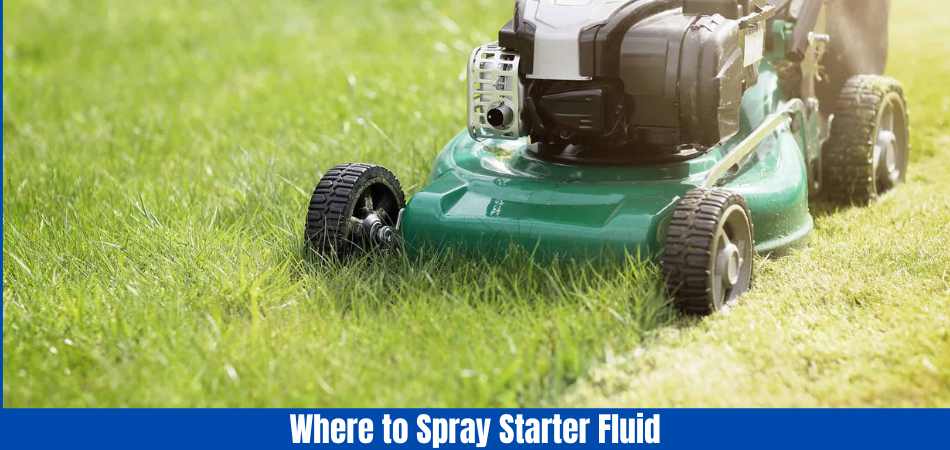
Perform this procedure in a well-ventilated area: The starter fluid is highly flammable and dangerous, so make sure you are working in an open, well-ventilated area. The fluid should not be ignited by flames or anything else. The engine should also be kept cool if it is hot.
When Is It Not Advisable To Use The Starting Fluid For The Lawnmower?
In the case of a diesel lawnmower, starting fluid should not be used as it can damage the engine. In addition, gasoline engines with two cycles are unsuitable for starting fluids.
If you notice something wrong with the lawnmower, it is best not to wait and to take it to a professional. You should change the starting fluid if the expert recommends it.
Carbureted engines work best with starting fluid since the fuel vaporizes through the little holes. As compared to starting fluid, other sprays are less effective.
In cold weather, gasoline does not vaporize, which causes problems.
It is true, however, that a starting fluid will easily ignite in the cold, aiding the engine to start and heating the fuel simultaneously.
How to Start a lawn mower with starter fluid?
You may need starter fluid the first time you use the mower in the spring. Cold weather also makes it easier to start the engine with starter fluid. The starter fluid can also be used to troubleshoot the small engine in the mower when it doesn’t start.
- You can start your lawn mower with starter fluid by following these steps:
- The lawn mower should be moved to a well-ventilated area and free of open flames.
- The air filter cover needs to be removed, and the filter should be pulled out.
- The air filter housing opening to the carburetor should be sprayed with starting fluid.
- Remove the air filter cover and reinstall it.
- Start the engine by pulling the starter rope or pressing the start button.
Can Starter Fluid Be Used On A Diesel Engine?
Diesel engines should not be started with starter fluid. Due to a different igniting method, starter fluid won’t be effective since they use a different method of igniting fuel. In addition, you should avoid using this product as it might damage your engine.
What Is Causing Your Lawn Mower Not To Start?
The process of figuring out what is causing your lawn mower not to start can be difficult. It is easier to diagnose a problem with starter fluid, however.
A carburetor or fuel pump issue will typically cause the mower to stall, and the time it takes to stall will tell you which one it is.
The process of diagnosing the problem at home should be relatively straightforward, but there are times when this may not be possible. The mower will need to be taken to a professional in this case.
How to Troubleshoot Common Lawn Mower Starting Problems?
Using starter fluid correctly can help start your lawn mower, but sometimes underlying issues need to be addressed. The following are some common problems that can prevent your lawn mower from starting:
1. Air filter that is contaminated or clogged
If your lawn mower’s air filter is dirty or clogged, it can restrict airflow to the engine, making it more difficult to start. Clean or replace the air filter using soap and water to resolve this issue.
2. An out-of-date or defective spark plug
When the spark plug in your lawn mower is worn or old, it can cause the engine not to start. The spark plug needs to be replaced, and the mower should be able to start again after that. You may need to address other issues if it still doesn’t start.
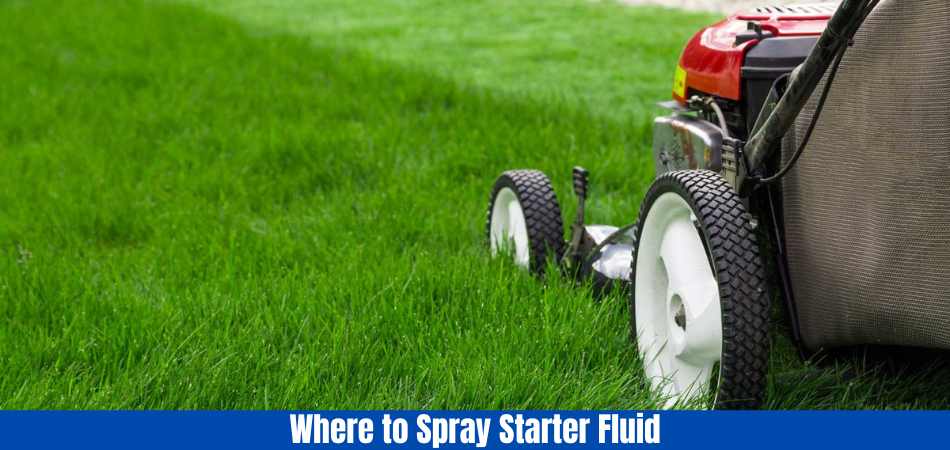
3. Gas that is stale or vacant
If your lawnmower has been sitting unused for a long time, the fuel may have gone bad and needs to be ignited properly. The old gasoline should be replaced with new gasoline, and the engine should be restarted.
4. The carburetor is incorrect.
If your lawn mower’s carburetor clogged or damaged, the engine won’t start. If your lawn mower is not working, you may need to clean or replace the carburetor.
5. Problems with electricity
Let’s say your lawn mower has an electric starter. It may not start if the battery or wiring is malfunctioning. Make sure the battery and wiring are in good condition.
How To Fix Lawn Mower Won’t Start Without Starter Fluid?
In the market, there are many known brands of amazing lawn mowers. Whether designed for professionals or homeowners, almost all lawn mowers have a similar primary mechanism. Because of this, most machines can be fixed with the same technique. Detailed instructions are provided below.
Step 1: Clean the lawn mower
A cleaning brush should used first to clean the lawn mower. Keeping things clean is good, even if it isn’t an amendatory part.
Step 2: Measure engine temperature
Keep an eye on the engine. Is it hot or cold? It’s OK if it’s at an average temperature. If not, wait until the temperature is cool; otherwise, it will damage the engine.
Step 3: Set your position
If you like, you can work on the engine in a place that suits you. You need to know where you can get every tool quickly. Fire extinguishers must also be available at the site.
Step 4: Start your work
It is now time to get down to business. In the beginning,
It is not necessary to remove the engine cover on all machines. Some have an engine cover, some don’t. Depending on the brand, it may vary. Using a 3/8-inch drive ratchet and socket, you can remove the cover.
You will find an air filter cover after removing the engine cover. Remove the cover with a Phillips head screwdriver.
It is necessary to remove the air filter: inside the sector, there is an air filter. You should take it outside.
The air filter house has been removed: An empty air filter house is now visible. Remove the House altogether with a ratchet and screwdriver.
Step 5: Take a look
Take a look at the surface now. What is the condition of the carburetor? The carburetor must first cleaned because a dirty carburetor cannot be revived by starter fluid.
Step 6: Spray Starter Fluid
Apply starter fluid directly to the carburetor by spraying for 2-3 seconds. Make sure the carburetor is in contact with the fluid.
Step 7: Start the Engine
Start the engine by pulling the starter string. See what happens. Your work is almost complete if the engine starts.
Step 8: Fix the parts
The parts need to be fixed in Step 8r house, ideally using the ratchet, then the air filter and air filter cover. Clean and dry all the parts. Once the lawnmower is covered with the machine cover, tie the screws appropriately.
Here is a step-by-step guide to help you apply starter fluid to your lawn mower.
What are the Safety Precautions when Handling Lawn Mowers?
It is important to remember that lawn mowers, despite their everyday use, can pose a safety threat if mishandled. You should wear appropriate work gloves and protective eyewear when operating a lawnmower. As a result of this equipment, accidents to the body can be prevented.
Furthermore, letting the mower engine cool off before performing any maintenance tasks recommended to avoid burns. Consumer Product Safety Commission (CPSC) guidelines provide a more comprehensive list of safety precautions.
By following these steps, you can enhance your lawn mower’s safety and functionality and reduce its environmental impact.
Whenever you face potentially risky situations, prioritize safety, adhere to proper waste disposal, maintain your equipment, and seek professional advice.
How to Properly Dispose Used Starter Fluid and Cleaning Material?
The management of waste is an integral part of any mechanical process. It is essential to dispose of used starter fluid and air filter cleaning materials in an eco-friendly manner. The incorrect disposal of waste can have a detrimental effect on the environment.
Accordingly, I recommend checking your local hazardous waste regulations or visiting the EPA’s website based on my wide experience.
It Provides comprehensive guidelines for disposing of such materials. Averting potential health risks by following these procedures reduces the environmental impact.
Safety should always be your number one priority if you are handling flammable materials like starter fluid. Mishandling this compound can result in significant harm, despite its practicality.
Be sure to work with starter fluid in a well-ventilated area away from open flames or sources of high heat. It prevents fumes from accumulating and potentially igniting, which can be extremely dangerous.
Final Remarks: Where to Spray Starter Fluid Lawn Mower?
The problem of starting is something that many gas mower owners will encounter at some point in their ownership. During periods when the lawnmower not used as often, they will occur more frequently. If the machine not maintained frequently or if it is not maintained at all.
However, you can often diagnose the problem by starting the machine using starter fluid. The carburetor is usually at fault when an engine fails to start.
The carburetor on your machine may need to cleaned, repaired, or rebuilt if it is older. Also, make sure the fuel adjustment is correct. Check the valve condition and clean them periodically if possible.
Read more of our articles here.
Read Also: Can you use starting fluid on a mower?
FAQs
Why do I need starter fluid for my lawn mower?
Internal combustion engines are started with starter fluid, which is a flammable liquid. Starter fluid may help your lawn mower start more easily if it has trouble starting.
What is the location of the carburetor on a lawn mower?
The carburetor mixes air with liquid fuel and is located near the engine. Most lawn mowers have it attached to their air filter and are easily accessible.
Do I need starter fluid for my lawn mower?
Use starter fluid if your lawn mower has trouble starting, especially after stored for a long time or in cold weather.
What is the best place to spray starter fluid on my lawn mower?
Starter fluid should sprayed directly into the air intake or carburetor. Place a small amount of starter fluid in the air filter housing, remove the air filter, and reinstall the air filter. Fuel is needed to start the engine, so this helps.
Is it safe to spray starter fluid on a hot engine?
A hot engine should not be sprayed with starter fluid, which could cause a safety hazard. Attempt to use starter fluid after the engine has cooled down.







Leave a Reply